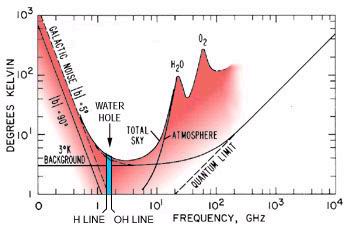SETI 的历史 - 3
<资料来源:The Planetary Society>
第3章:SETI的蓝图
Morrison and Cocconi's short article became the blueprint for most of the SETI projects conducted in the past 40 years. The suggestion that electromagnetic signals were the most promising means for interstellar communications became the underlying assumption of all the searches, including the optical ones. The assumption that any alien signal would exhibit a Doppler drift has also been incorporated into all subsequent SETI projects, which invariably check for signals at drifting frequencies. But most important of all was their suggestion of a "universal" frequency that the aliens would most likely use for their transmissions. 1420 MHz has remained the most popular frequency used by SETI projects to this day.
In later years another SETI pioneer, Hewlett Packard Vice President Bernard Oliver, added another magic frequency, 1662 KHz, the emission frequency of another very common molecule - OH, or hydroxyl. Hydrogen and hydroxyl combine to form H2O - water - the basic component of life, as we know it. Since 1662 KHz shares the advantages of 1420 MHz in being in a relatively "quiet" region of the spectrum, Oliver came to believe that the band between them held some unique promise for detecting an alien signal: "Surely the band lying between the resonances of the disassociation products of water is ideally situated and an uncannily poetic place for water-based life to seek its kind," Oliver wrote in 1971. "Where shall we meet? At the water-hole, of course!" Since then, the term "water hole" has been used to refer to searches at or around the hydrogen emission frequency.
Morrison and Cocconi's article was a call for action, and they hoped to put their theory to the test. Cocconi contacted Sir Bernard Lovell at the Jodrell Bank radio observatory, the largest dish in the world at the time, and suggested devoting telescope time to search for an extraterrestrial signal. Sir Bernard was, however, skeptical, and nothing came of the venture. The launch of the first radio search for an alien signal was left to others.
第2章:SETI成立的瞬间 ← | → 第4章:Ozma项目的起源
